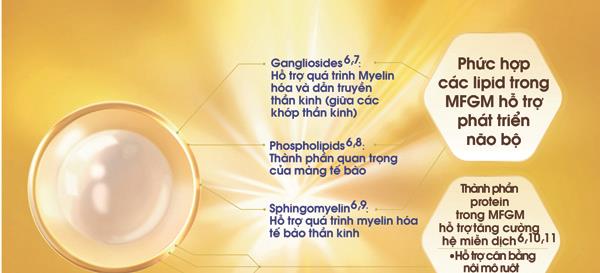15 years ago, for the first time, DHA was added to infant formula milk, becoming an important revolution. Science has proven that DHA is an essential nutrient indispensable in children's nutrition, playing an important role for brain development, especially in the first 5 years of life.
content
From DHA to MFGM: An important step forward in the nutrition industry
The breakthrough ingredient MFGM is now present in formula milk
Recently, another breakthrough ingredient has been discovered and proven by scientists to help promote the development of thinking (IQ) and emotional intelligence (EQ) in children. That breakthrough nutritional ingredient is called: MFGM.
From DHA to MFGM: An important step forward in the nutrition industry
After 15 years from the time DHA was added to formula milk, no modern mother still has to wonder what DHA is. FAO / WHO considers DHA to be an essential nutritional component in the first 5 years of a child's life, because in this stage, the child's brain develops very quickly and DHA plays an important role in brain development.
However, breastmilk has always been the gold standard for infant nutrition that scientists constantly learn, and after many years of research, scientists have found that there is a single ingredient in the ingredients of breast milk. Crucially, it is very nutritious and has been shown to play a key role in supporting the thinking (IQ) and emotional development (EQ) of infants and young children. This ingredient is called MFGM.
MFGM (Milk Fat Globule Membrane) is a three-layer membrane surrounding the fat drop of breast milk, produced in the mammary epithelial cells. MFGM has a complex structure with more than 150 different types of bioactive lipids and proteins. MFGM derived from breast milk and cow's milk both have polar lipids, sterols, proteins and glycoproteins, enzymes and other biological activities. MFGM is present in cow's milk and is largely lost during production in the conventional way, but with modern ultrafiltration technology the MFGM can be maintained in high concentrations.

The fats are in MFGM
In particular, preclinical studies have shown that DHA and MFGM together have the ability to increase connections between brain cells compared with DHA alone supplementation. Not only increasing brain connection in children, MFGM is also proven to contain many components that support the health and immune system for children: reduce the rate of otitis media (2), reduce the number of days with fever (3), reduce the risk of diarrhea (4).

Clinical studies demonstrate that MFGM has a positive effect on children's thinking development (IQ) and emotional intelligence (EQ).
According to experts, MFGM is considered as a breakthrough achievement, the next remarkable discovery of DHA in child nutrition. MFGM is a new "golden key" of nutrition for children in the world.
The breakthrough ingredient MFGM is now present in formula milk
In the past when processing cow's milk formula, the majority of the MFGM contained in the milk was lost during the production process, only until advances in current production technology have been achieved, the MFGM could be retained was successful and put back into formula
This means that mothers can support and improve the quality of nutrition for children, helping children get the best nutrition for brain development in thinking (IQ) and emotional intelligence (EQ), Present through 6 main skills: critical thinking, concentration, communication (IQ), problem solving, collaboration and empathy (EQ)
Studies show that optimal nutrition in the first years of life will have a profound and long-term impact on the overall brain development of children in the future. And with the breakthrough findings about MFGM recently, mothers have the right to believe that the world children's nutrition will continue to bring miracles to their children, such as discovering DHA. from 15 years ago used to do.

*Note:
(1) Research by Timby 2014 et al. On MFGM supplementation to support cognitive function in infants
(2) Research by Timby 2015 et al
(3) Veereman-Wauters et al. On MFGM 2012














